Distressing, controversial, politicized, these are just some of the adjectives that might be applied to the works in Portraits of Cain, the new exhibition mounted at the Ben-Gurion University of the Negev. Featured there are some 100 works, photos, paintings, prints and sculpture by 28 Israeli artists, past and present.
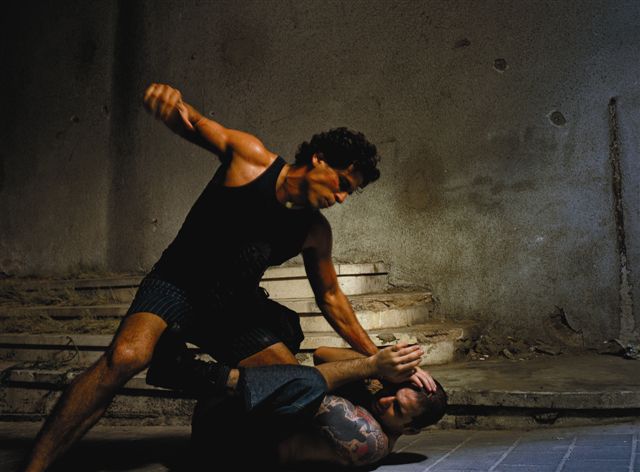
While the story of Cain (Genesis 4 1:16) is the core around which this exhibition has evolved, only a few of the participating artists deal directly and effectively with the act of violence when Cain slew his brother. Most striking, in this respect, are Adi Ness‘s staged color photos; one depicting the lifeless body of Abel, the other, the fight itself – where the positioning of the figures looks back to a famous painting of Cain slaying Abel by the Flemish master Peter Paul Rubens. As models for the recreation of this scene, Nes employed actors from a no-rules wrestling club, neither of whom apparently wanted to play the role of the vanquished Abel.
Nes’ photos, together with large format works by three other artists portraying either an assailant or a victim hang at the entrance to this show. They serve as a valuable introduction to the main display area where the biblical story and relevant works of art branch out in different directions, among them, the perception of the ‘Other’, branding; and the cult of violence that is such a feature of contemporary life.
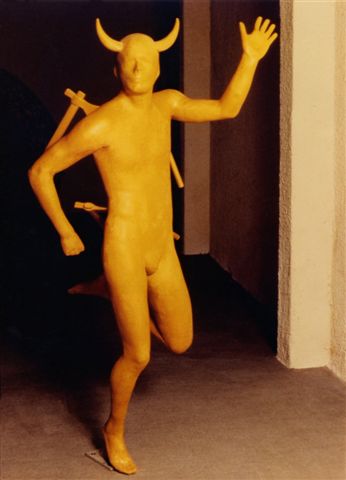
The Other – the person who is different or strange is the subject of Angelo-Angelo, the important piece that Motti Mizrachi is showing here, (the title alludes to Michelangelo’s statue of a horned Moses). Mizrachi, physically handicapped from birth, was one of the first Israeli artists (at first through performance art, later with sculpture) to focus on a subject which today has become a popular theme for art exhibitions. Displayed here is a small replica of the 180 cm. high polystyrene figure that Mizrachi showed in 1988 at the Venice Art Biennale (see above). This nude figure, horns attached his head, axes wedged into his back, gives the impression of a man – an outsider – in flight from his tormentors.
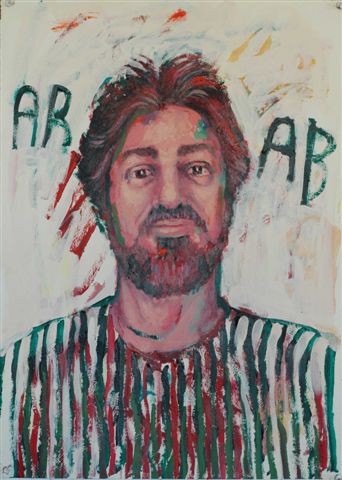
Within an Israeli context, the Other has inevitably come to have socio-political connotations, also in art. One telling example is a set of self-portraits by Asad Azi from his I am a Good Arab series. Here, charcoal drawings of the face of a pleasant middle aged man are juxtaposed with stereotyped images of himself, crudely painted in green and red, the colors of the Palestinian flag. Another angle is pursued in Gaston Zvi Ickowicz’s portraits of Jews, settlers in the West Bank who are undoubtedly regarded as heroes within their own community. Sited opposite – and a similar comment might apply – is Miki Kratsman‘s Wanted photo series in which a dozen or so harmless looking youths from the Jenin refugee camp turn out to be top terrorists wanted by the IDF.
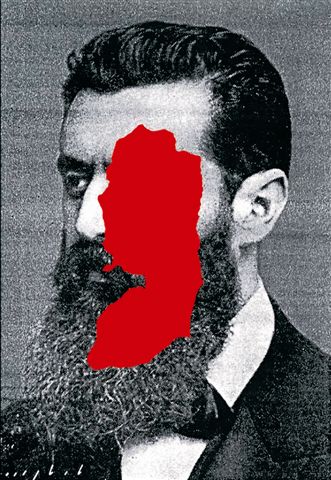
Branding is the subject of a number of visually striking exhibits, in particular, Stain, a poster series by David Tartakover in which a red blot in the shape of the West Bank covers the faces of Theodor Herzl and Israeli politicians. Natan Nuchi has chosen an unusual method to ‘brand’ a person: a wall display of tee-shirts imprinted with a single word or text that signifies that the wearer is part of a minority group or of a certain political or religious persuasion. An offbeat contribution comes from Ken Goldman. It is a knitted skullcap on which the words Haf Mipeshah (Innocent) are stamped, the intention being to mock criminals who turn to religion as a means of getting special privileges and a reduced sentence.
Holocaust-related works focus on the subject of branding. The simplest and most successful is Vardi Kahana‘s photo from her One Family series. With a nod, perhaps, to American photographer Nicholas Nixon’s well known photos of the Brown Sisters, Kahana has taken a ‘group portrait’ of her mother and her two sisters. Sleeves rolled up to display the concentration camp number stamped on their forearm – the Nazi’s mark of Cain, the women nevertheless look steadily and confidently into the camera. .
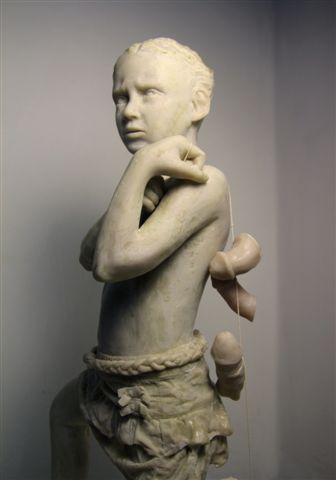
There are many works in which violence is a visible or inferred component, as is the case with First Blood, a sculpture of a young girl by Vered Aharonovitch. This is a standout piece since the artist has succeeded in creating an aura of evil around this figure, as well as suggesting the vulnerability of childhood. From several aspects, one is reminded of Michelangelo’s portrayal of David before his battle with Goliath.. But where this classical figure has a slingshot hoisted over his shoulder, Aharonivitch’s little warrior drags her trophies along on a string. What are they? A store of castrated penises.
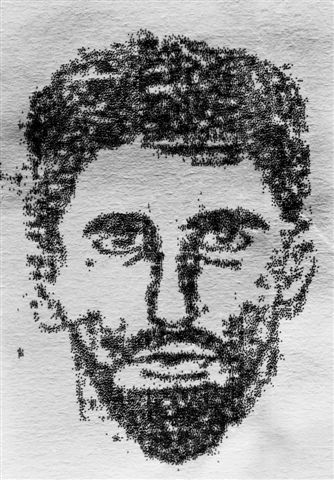
Arnon Rabin‘s digital prints from his Targets series could be viewed as a kind of homage to violence. A marksman in the army, he based this work on the paper targets of impersonal figures that were used during training. Blown up and digitally manipulated, each face, seemingly formed from loose particles of charcoal, is now seen to possess individual traits. As in Kratsman’s Wanted series, the ‘terrorist’ or ‘wanted man’ becomes a real person not a stereotype or an amorphous image.
This is a show that illustrates very convincingly that the biblical story of Cain and its ramifications are of major interest to many contemporary Israeli artists. But the work of one artist is missing. I refer to Haim Maor who for decades has dealt with this very subject; from the Mark of Cain (the title of his first Tel Aviv show in 1978), through images of branding associated with the Holocaust, to an investigation of the Other’s place in society. But, as it stands, Maor’s role in the production of this exhibition has precluded his participation. The 33 students who curated this excellent show are all third year art history students taking the mandatory Curatorship Course that Maor has given annually at the University for more than a decade.
In conversation, Maor told me that he always impresses on his students that the artist must be the star of an exhibition, not the curator – as is so often the fashion today. He went on to speak of the systematic and very thorough way that his students are taught to ‘create’ an exhibition (choice of theme, selection of artworks, interviews with artists, preparation of catalog and texts, design of the show and much more.). It soon became clear that no other institute of higher learning in the country offers their students such a high quality, hands-on course in curatorship.
This exhibition is warmly recommended both for the variety of topics it deals with and the questions they raise, and for its immaculate presentation, a model of its kind.
The Senate Gallery, Ben Gurion University, Beersheba. Till June 10th.





